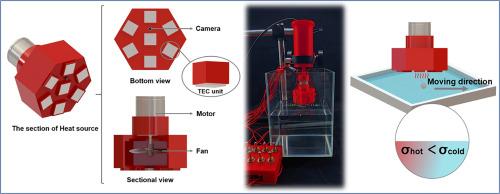气液界面非接触式热毛细管驱动系统
IF 8.3
2区 材料科学
Q1 MATERIALS SCIENCE, MULTIDISCIPLINARY
引用次数: 0
摘要
非接触驱动技术具有非接触、无磨损、低噪音等优点,在各个领域得到广泛应用。热毛细管驱动是气液界面非接触驱动的有效方法。当气液界面存在温度梯度时,就会产生表面张力梯度,从而驱动界面上的微型物体运动。本研究提出了一种利用热电冷却器(TEC)阵列作为热源的系统,它可以改变气液界面的局部温度,并产生表面张力梯度,从而推动界面物体的运动。实验结果表明,直径为 0.5 毫米的泡沫颗粒的最大移动速度可达 2.1 毫米/秒。此外,该系统还能控制气液界面上的多个微型物体进行自组装。我们还开发了一种微型仿生水黾机器人,该系统可驱动机器人在气液界面上进行直线和转弯运动。该系统为气-液界面的非接触式驱动提供了一种新方法。本文章由计算机程序翻译,如有差异,请以英文原文为准。

A non-contact thermocapillary driving system at the gas-liquid interface
Non-contact driving technology is widely utilized in various fields due to its advantages of being non-contact, wear-free, and low noise. Thermocapillary driving is an effective approach for non-contact driving at gas-liquid interfaces. When a temperature gradient exists at the gas-liquid interface, it generates a surface tension gradient, which drives the movement of micro-objects at the interface. This research proposes a system that utilizes an array of thermoelectric coolers (TECs) as a heat source, which changes the local temperature at the gas-liquid interface and generates surface tension gradients for driving the movement of interface objects. Experimental results demonstrate that foam particles with a diameter of 0.5 mm can achieve a maximum moving speed of 2.1 mm/s. Furthermore, the system can control multiple micro-objects at the gas-liquid interface for self-assembly. We have also developed a miniature biomimetic water strider robot, this system can drive the robot to perform linear and turning movements at the gas-liquid interface. This system provides a novel approach for non-contact driving of gas-liquid interfaces.
求助全文
通过发布文献求助,成功后即可免费获取论文全文。
去求助
来源期刊

ACS Applied Materials & Interfaces
工程技术-材料科学:综合
CiteScore
16.00
自引率
6.30%
发文量
4978
审稿时长
1.8 months
期刊介绍:
ACS Applied Materials & Interfaces is a leading interdisciplinary journal that brings together chemists, engineers, physicists, and biologists to explore the development and utilization of newly-discovered materials and interfacial processes for specific applications. Our journal has experienced remarkable growth since its establishment in 2009, both in terms of the number of articles published and the impact of the research showcased. We are proud to foster a truly global community, with the majority of published articles originating from outside the United States, reflecting the rapid growth of applied research worldwide.
 求助内容:
求助内容: 应助结果提醒方式:
应助结果提醒方式:


